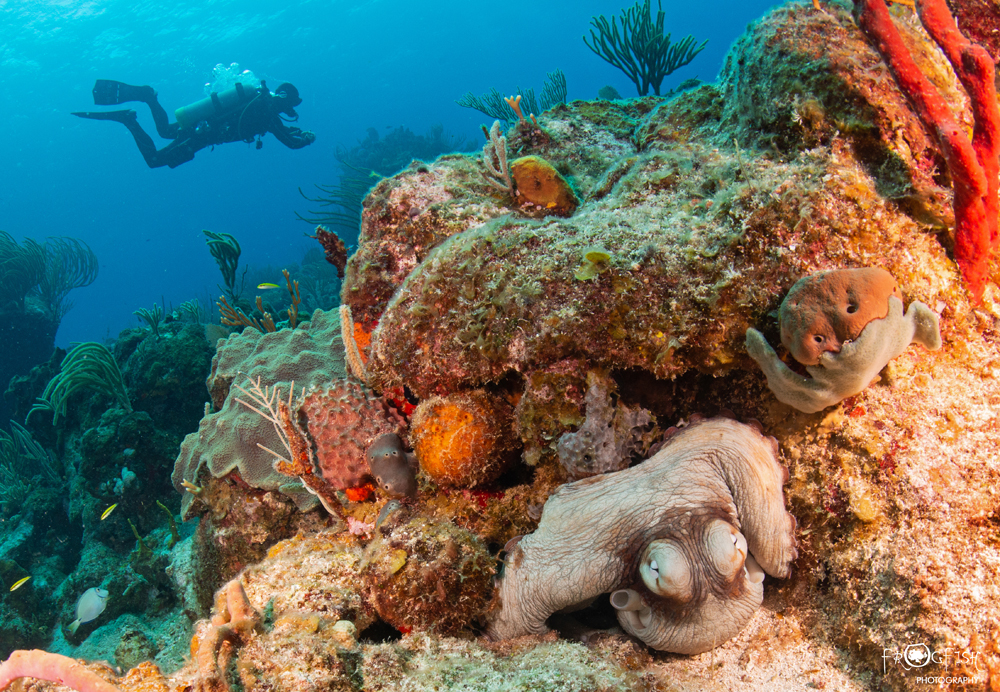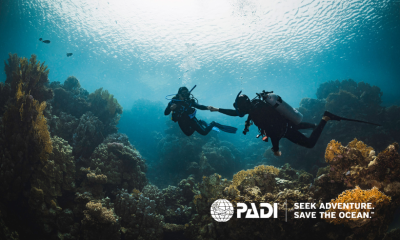Blogs
Great Hammerhead Sharks in Bimini, Bahamas

Bimini is becoming one of the most popular shark diving destinations in the world with divers and underwater photographers flocking to these tiny islands in The Bahamas to experience diving with Great Hammerhead Sharks. The dive offers the opportunity to get up close to these impressive sharks that can be up to 5m in length.
We arrived on the south island and jumped on the ferry to take us the 2 minute crossing over to the north island and our accommodation for this part of the trip, Bimini Big Game Club. This is where the Neal Watson Bimini Scuba Centre is located and where, once we had unpacked, we would be heading out for our Hammerhead Shark experience. The hotel hosts plenty of sport fishing boats, and because of the gutting of the catch each evening, the water surrounding the hotel is filled with Bull Sharks. It makes for a special post dive beer on the balcony, watching them gliding below the surface from your table.
The hammerhead shark dive is based quite close to shore, and so the journey out to the site is short; however, the preparation time and the wait for the sharks to turn up can take several hours. In our case, we were very lucky and the first sharks appeared almost instantly and we were soon gearing up and jumping in the water, but not before a thorough briefing from the crew to ensure everyone knew where to go and how to behave…
Descending down the line we could see three Hammerhead Sharks already slowly circling the sandy seabed, as well as a handful of Nurse Sharks and a solitary Bull Shark on the periphery. We took up our position, kneeling on the sand, and waited for the sharks to come in close, and they do come in very close! It is an incredible experience and one that is unique to this island, as you sit on the sandy seabed in less than 10m of clear blue water and these magnificent sharks swim past you. One dive guide is situated in the middle of the group, with a bait box, occasionally giving a shark a fish for their troubles, and an additional dive guide stays behind the group to watch over proceedings.
As it is so shallow, and the whole experience is really relaxed, you can stay for as long as your tank lasts and then head back to the boat for refreshments and a new cylinder, before heading back down for some more hammerhead action. This dive is a real treat for divers and underwater photographers alike.
For more information please visit:
Text, Images and video by Nick and Caroline Robertson-Brown of Frogfish Photography – www.frogfishphotography.com
Blogs
BVI Wreck Week – Diving (Part 3)

![]() BVI Wreck Week allowed us to dive several of the wrecks the BVI has to offer, as well as sampling some of the best reef sites too. Our previous blog focused on the wreck of the RMS Rhone, so in this one we will try to give you a taste of the rest of the diving on offer.
BVI Wreck Week allowed us to dive several of the wrecks the BVI has to offer, as well as sampling some of the best reef sites too. Our previous blog focused on the wreck of the RMS Rhone, so in this one we will try to give you a taste of the rest of the diving on offer.

And there is a great deal of wonderful diving to tell you about. Our first day of diving did not offer the best visibility due to heavy rain earlier in the week. However, we were taken to a rugged dive site that had Caribbean and Lemon Sharks swimming all around us. If we had been able to see the usual 20m+ I am sure we would have been able to talk of dozens of sharks on the site.

The BVI has plenty of artificial reefs, created from wrecks deliberately sunk. A couple of these are artistic creations from Beyond the Reef. The Willy T is a pirate themed party boat sunk in shallow water that now has skeletons of pirates duelling on the deck and going about their dastardly ways. It is a lot of fun and once you have had your fill, you can head up onto the shallow reef. Shark-plano is a series of three planes that were damaged in a hurricane, that have been turned into shark species and sunk. Both these sites are perfect for the diver that loves a bit of Instagram appeal!

Wreck Alley has a series of three boats sunk to create a super dive site perfectly aligned for a single dive where you can explore them all. Moray eels can be seen free swimming along the decks, huge stingrays back the sandy seabed their home. Turtles cruise past as you make your way around and then up onto the reef for your safety stop.
On every dive we did we saw sharks which absolutely delighted us. The local dive shops seem to be particularly engaged in conserving the reefs, taking part in coral reef restoration, lionfish hunting, cleanups and logging their sightings. We were filled with positivity at the end of each day.

We hope that we can return to do it all again at BVI Wreck Week 2024!
Watch out for our full feature on BVI Wreck Week in the next issue of Dive Travel Adventures coming out in July.
For more information about BVI Wreck Week 2024 visit their website here.
Nick and Caroline were hosted by BVI Wreck Week
The Moorings provided their yacht for the week
Host Dive Centres:
Blogs
BVI Wreck Week – Diving the RMS Rhone (Part 2)

![]() You cannot talk about BVI Wreck Week, or diving in the British Virgin Islands, without spending some time on the jewel in their crown of wreck diving – the RMS Rhone. So this blog is going to be dedicated to a wreck dive that we were happy to dive three times on our trip and would have been happy to dive every day!
You cannot talk about BVI Wreck Week, or diving in the British Virgin Islands, without spending some time on the jewel in their crown of wreck diving – the RMS Rhone. So this blog is going to be dedicated to a wreck dive that we were happy to dive three times on our trip and would have been happy to dive every day!

The RMS Rhone was a UK Royal Mail Ship wrecked off the coast of Salt Island on 29 October 1867 in a deadly hurricane. Now it is the most popular dive site in the region. The dive briefings for the site are filled with stories of the fate of the ship and some eye-opening tales since.
The wreck and surrounding area become the British Virgin Island’s first national marine park in 1980. Many of the underwater segments of the 1977 thriller The Deep were filmed on the Rhone, requiring actors Jacqueline Bisset, Nick Nolte and Robert Shaw to learn how to scuba dive.

You’ll need at least two dives to fully experience the RMS Rhone. The ship split apart on sinking and the bow drifted just a little before sinking. The two halves are about 100 feet apart with the bow sitting in deeper water (around 25 meters / 80ft). So you are best to explore the bow fully on a single dive and then head to the stern on your second dive.

Whilst the history, artifacts and stories from the movies are absorbing, as soon as we got underwater to dive her, it was the incredible marine life that had us hooked. Two seahorses had made their home right at the bow of the wreck. Stingrays lay buried in the sandy sea bed. The structure is covered in colourful corals and sponges. Schools of fish occupy the overhangs and metal remains. We saw sharks on all three dives and were treated to a huge spotted eagle ray gliding over the wreck. Lobsters waved their antennae at us from every crevice. Life is everywhere you look on this dive.

The marine park status has certainly ensured that this is one of the best wrecks we have dived in the Caribbean. Whilst we did not get the chance to do this – we bet it would make an awesome night dive.

Check out our next blog to find out more about the diving and watch out for our full feature in the next edition of Dive Travel Adventures Magazine in July!
For more information about BVI Wreck Week 2024 visit their website here.
Nick and Caroline were hosted by BVI Wreck Week
The Moorings provided their yacht for the week
Host Dive Centres:





















